


 |
December 13, 2014: A Book Club Christmas |
 |
November 27, 2014: Thanksgiving in Dallas |
 |
Return to the Index for 2014 |
Prudence asked Fred and I right after we got back from South America if we would come down to San Antonio to visit them and help Karl celebrate his birthday, and we said that of course we would like to come visit them. It is always a pleasure to visit Prudence, Ron and Guy, and Fred and I never have to be asked twice.
Getting to the Ruckmans' House in San Antonio
On the maps below, you can see the route to the Ruckmans' house. It is an easy matter to simply hop on I-35E from the Tollway in Dallas and take that highway all the way south through Austin to San Antonio. This 280-mile trip routinely takes about 4.5 hours. In San Antonio, we continue to follow I-35 into the city, eventually exiting onto San Pedro Avenue. We take that north about two miles, and either hang a left on Ashby and a right on Breeden or just a left on French to get to the Ruckmans' house on the northeast corner of Breeden and French.
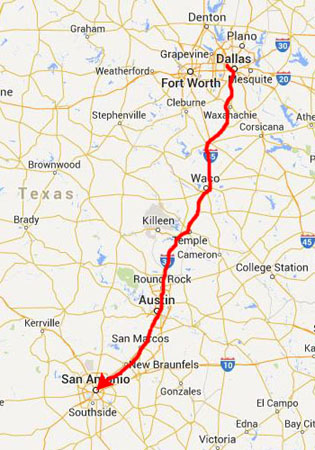 |
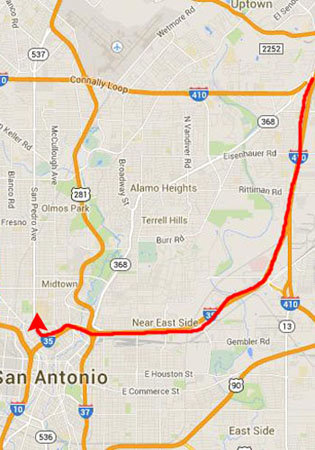 |
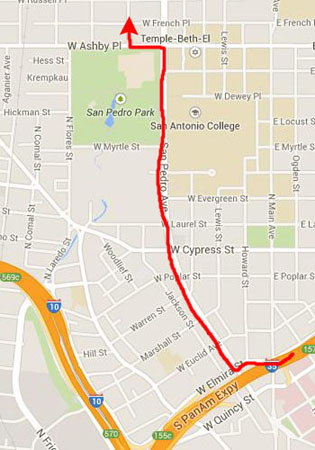 |
In case you have not seen them, I have put below first an aerial view of the Ruckmans' house (it is the house on the corner and the garage/apartment building north of it where Guy lives) and a front view of the house (taken in 2010).
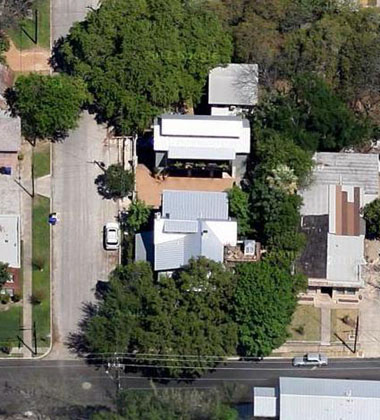 |
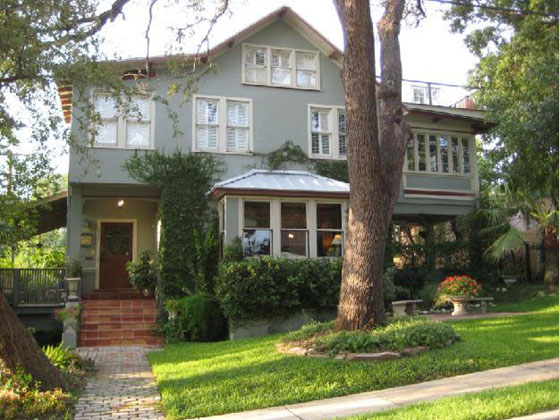 |
The New Sunroom at the Ruckmans' House in San Antonio
|
What Prudence did was to first extend the patio all the way along the dining room to the back wall of the house. This required extending the concrete another four or five feet. Now she had a big rectangle of concrete the full width of the house on its east side. Then she had this entire area enclosed with large glass windows and doors, and covered the area not already underneath the Sun Room with a glass ceiling, peaked in the middle. The open archway was also closed in and French doors put in there, and the low wall on the right had windows built on top of it going up to the ceiling. If you stand at the original French doors from the living room and look straight out, this is what you see now. Of course, the project is not done yet, and there is still a good deal of interior trimwork to be completed.
You can get another view of the new sunroom if you exit the doors from the living room, turn left, and walk all the way to the new north wall of the room and turn and look back to the south. You can see that view here.
As you can see, the new room is one large open space, and Prudence will eventually be putting nice furniture out here. Next, the wall between the dining room (that is the wall to the right in the previous picture) and this new room was opened up, and two sets of French doors put in there, so on nice days they can be opened. There are also French doors on the outer east wall of the new patio area that lead out to the garden. The end result will be a room that can be totally indoors during the winter or inclement weather, but which can become a large, covered outside space during spring and fall and the cooler days of summer. It makes quite an addition to the house.
You can see two more views of the outside of the new sunroom here and here.
Visiting the San Antonio Botanical Garden with Guy
|
One of the first things Guy did when he moved to San Antonio in July was to get a membership at the Botanical Garden so he can come here frequently and walk. Apparently, he does this at least a couple of times a week. If I lived nearer to the Dallas Arboretum, I'd probably go more frequently as well.
|
Getting to the gardens is just a fifteen-minute trip from Ruckman Haus, and I knew the way quite well. I didn't put a distance scale on the map at right, but the whole trip is a little less than three miles.
I think there are a number of reasons why Guy comes to the gardens frequently. They, like the Dallas Arboretum, are not only a delight to the eyes, but provide rest for the soul as well. That rest is something Guy treasures, and something we should all get more of.
|
Today we saw a butterfly with a 5-foot wingspan, a 4-foot-long bee hovering in the air and a towering 7-foot-tall rose- among other amazing sights. No, it wasn't science fiction; these and another two dozen more larger-than-life plants, animals and insects were each made up of thousands of LEGO bricks as part of artist Sean Kenney's garden-inspired exhibit, "Nature Connects".
Local horticulturalists and garden crew members were joined by consultants from Reiman Gardens in Ames, Iowa (the property that owns and lends out the sculptures) for the installation. The exhibit highlights the connection between humans and nature, and signs at each of the sculptures indicated the number of LEGO bricks connected within each piece. So on our walk today, I'll show you some of these amazing LEGO creations.
The entry to the gardens is through what looks like an old Texas house with a rural metal roof; it contains the normal acoutrements of gift shop, restaurant, offices and exhibits. You can see it in this picture of Guy and I just inside the garden.
|
 |
As we came up into the gardens, we found that some of the beds had just been planted with winter flowers- pansies in this case. And in a rather odd note, there were four or five fake trees painted in primary colors that added some cheeriness to an otherwise overcast afternoon.
Just past those new beds we found ourselves in the formal garden area between the rose garden to our north (no roses at this time of year, of course) and the Japanese Garden south of us. Here we found an interesting birdbath (I assume it was a birdbath) that was actually a sculpture entitled "Windswept I". This area also has a couple of nice fountains and, at least on this visit some gigantic Adirondack chairs also painted in bright primary colors. They are a great photo op, and some of the pictures we took here in this area of the garden featured them. Just click on the thumbnails below to have a look at some of these pictures:
 |
Along the south side of the gardens are arguably the most iconic features of the San Antonio Botanical Garden- the Lucile Halsell Conservatory.
|
Most conservatories have all of their display areas connected by hallways or smaller rooms. Because of San Antonio's mild climate, the visitor here can enter rooms that are separate and only accessible via an open-air courtyard. The project is actually five separate conservatories built around this courtyard. Not only does the climate help make this design work, but the arcades (overhead covered areas) also provide protection from the elements.
A unique design feature is the subterranean effect of the Conservatory. As visitors enter the front, they actually go underground through a tunnel. At the entrance, the project is cut into the original grade by three feet, with soil over the entryway. The Palm House is cut 20 feet into the earth, with the original exterior grade surface remaining unchanged.
Basically, all of the rooms are sunken in the ground and have a glass roof at least 18 feet above the floor level. The largest glasshouse, the palm pavilion, soars 65 feet at its highest point. It has a waterfall that is itself about 30 feet high. The fern room is actually 23 feet below the surface. This design is successful in San Antonio because of the quality and quantity of sunlight. The sun is almost overhead in the summer and only dips 22 degrees above the horizon at its lowest point in the winter. Another unique feature is that only the glass roofs protrude above the earth’s surface. All mechanical rooms, offices, and backup areas are underground, allowing for the very clean, uncluttered look of the landscape.
Below are clickable thumbnails for some of the pictures that we took as we walked through the Conservatory today:
 |
From the conservatory, we walked north through the gardens to the Texas Native Trail. The Trail is a unique aspect of the San Antonio Botanical Garden, and consists of plant communities characteristic of the Hill Country (Edwards Plateau), East Texas Pineywoods, and South Texas. These three distinctive and diverse ecological regions of Texas vary in soil, plant life, topography, and weather. The authentic botanical setting is enhanced by several early Texas houses, which have been reconstructed on the site to help illustrate and interpret the regional theme.
|
This authentic hand-hewn post oak log cabin from Fayette County, built in the 1850s, sits at the lake’s edge. Its deeply shaded wraparound porch provided ample protected space for the daily needs of pioneer life. Inside, the house consists of one room with a fireplace and a high ceiling. Evidence of a loft remains. The house is accompanied by the barn, smokehouse, and wellhead from its original environs at Park, Texas, near LaGrange.
With no stores around the corner, pioneer homesteads like this one relied on the nearby kitchen garden to spice up meals of farm-raised pork or fresh game. Women were usually the ones to care for the small kitchen garden that provided fresh vegetables, herbs, and fruit for the family, while men tended farm crops of corn, cotton, and beans. One of the LEGO sculptures (see below) was found here in the garden. When moved to the Garden, the buildings were carefully indexed, dismantled, relocated, and reconstructed in an ecologically accurate setting to illustrate the early Texans’ dependence on native vegetation.
Right in front of the cabin, there is a stairway down to the pond. Right near the stairs there is a little machine that vends duck food, so we got some and walked down to the water to feed the ducks that were swimming around. We had to go back for more food it was so much fun to feed them. Out in the lake there was a log with ducks and turtles on it.
We continued walking around the lake and started back towards the entrance. We passed across one open lawn where eight or ten cardinals were feeding; I didn't recall ever having seen so many in one place at one time.
Now for the LEGO creatures. We did not do an exhaustive search to find all of the animals and flowers; there were reportedly two dozen of them. But we did run across a few of them.
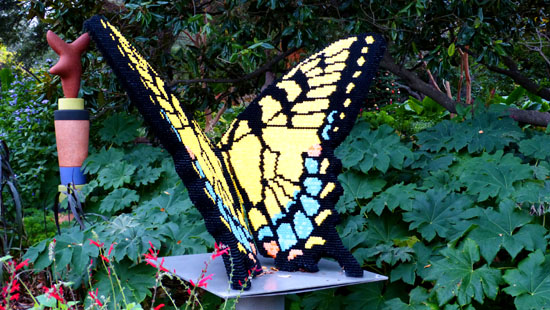 Butterfly |
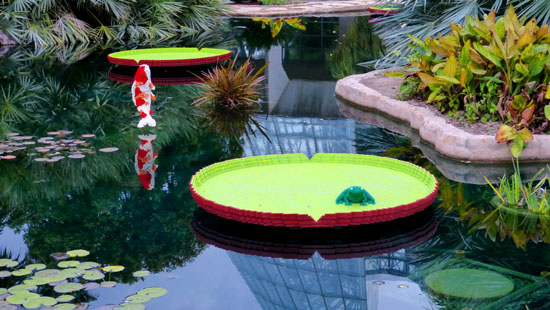 Koi, Lily Pads and Frog |
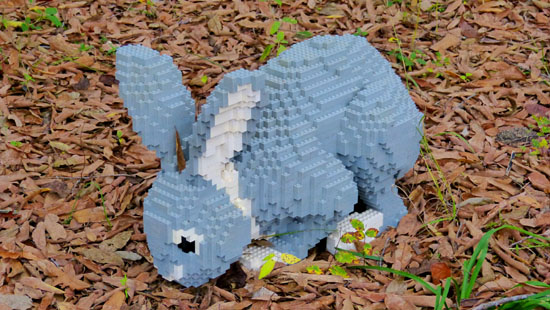 Rabbit |
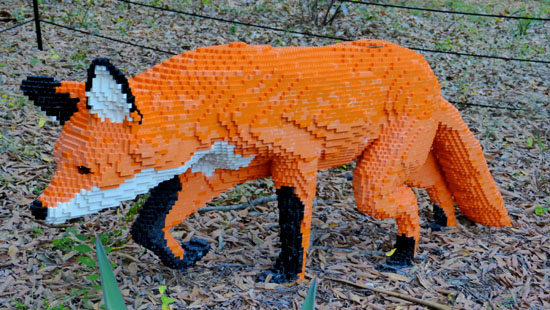 Red Fox |
|
This creation took 13,704 LEGOs to build, and for reference it is 73 inches long, 21 inches wide and 41 inches high. We read from its accompanying sign:
| "While lawns are not as wild as natural areas such as a prairie or forest, they are an important part of the "habitat" of cities and towns. Lawns can handle heavy foot traffic and create areas for play. The way we care for our lawns can affect the health of streams, ponds, and other places where plants and animals live. Under-used turf takes away from more earth-friendly plants and may require a lot of water. Could you reduce the amount of lawn in your yard? If everyone in the United States did, it would enrich millions of acres and help the environment!" |
|
Hummingbird and Flower
This creation took 31,565 LEGOs to build, and for reference it is 64 inches long, 32 inches wide and 77 inches high. We read from its accompanying sign:
| "You can tell a lot about a bird by its beak. Each bird is adapted to its main type of food. The long, narrow beaks of hummingbirds allow them to drink nectar from deep within a flower. Beyond their beaks, hummingbirds inspire wonder for their incredible aerial abilities! They are the only bird that can fly in any direction, with 53 wing beats per second. Although many weigh less than a penny, these tiny creatures migrate for thousands of miles and fly across the Gulf of Mexico. Humans have learned many lessons about aerodynamics and flight from the hummingbird." |
|
There are two figures here. The Bison took 45,143 LEGOs to build, and is 80 inches long, 26 inches wide and 50 inches high. The accompanying calf took 16,229 pieces to build; it is 50 inches long, 15 inches wide and 34 inches high. Here is a closeup of the bison's head. We read from its accompanying sign:
| "The bison is a famous symbol of the American West. these shaggy animals are the largest land mammal in North America, shaping the cultures of many Native Americans. Although you will not find bison here, you can find many of the plants they grazed when they roamed this land. Bison are a conservation success story, returning from the brink of extinction to become a vital animal in large nature parks and ranches." |
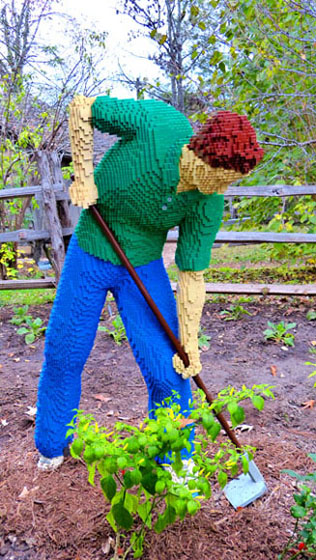 |
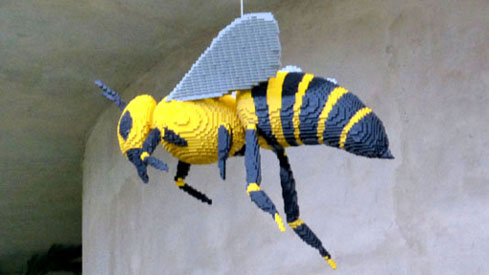 |
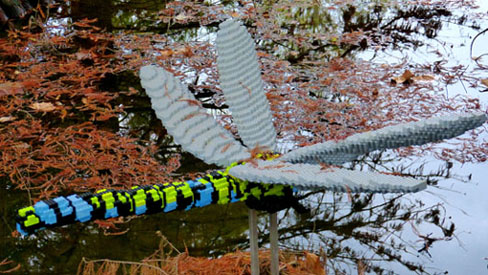 |
We enjoyed our short walk through the Botanical Garden, and we can easily see why Guy comes here so frequently!
Karl's Birthday Dinner
 Guy, Drew (standing), Shawn, Ron Ruckman (standing), Nancy (standing), Prudence (standing), me and Karl |
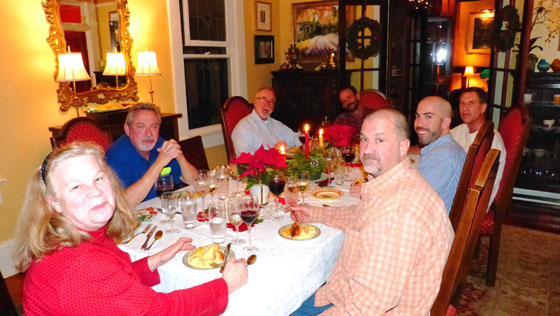 Nancy, Ron Ruckman, Karl, Fred, Shawn (near camera), Drew and Guy |
Drew, a teacher at UT/San Antonio, and Shawn, bartender at the V-Bar downtown, are friends of Ron and Prudence. The dinner was really good, and I just had to get Prudence's lasagna recipe. We all had a good time, especially the birthday boy with his cake. Below are clickable thumbnails for some other candid pictures that we took during the evening:
 |
We had a really good visit with everyone this time around, and we will look forward to coming back again sometime soon.
You can use the links below to continue to another photo album page.
 |
December 13, 2014: A Book Club Christmas |
 |
November 27, 2014: Thanksgiving in Dallas |
 |
Return to the Index for 2014 |